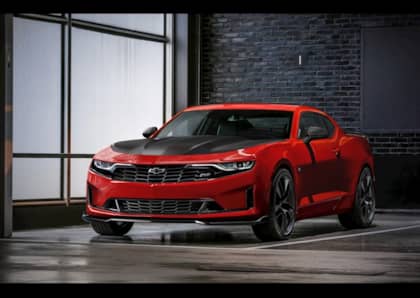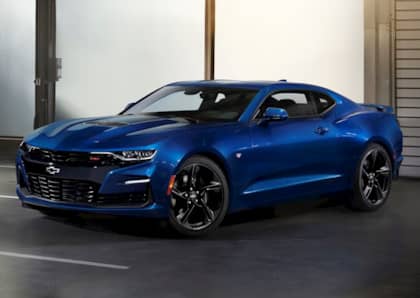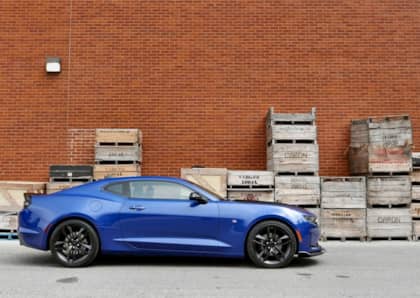From Showroom Stock To ZL1: A History of the Chevrolet Camaro 1LE
The Chevrolet Camaro has always had a strong racing history—and not just in a straight line. Although classic Camaros are more often celebrated for their drag strip cred than their ability to turn a corner, Chevrolet has also let its pony-fighter out to play on road courses, too, starting way back with the first-generation coupe in the Trans-Am series, as well as the International Race of Champions (where the second-gen model was the official car for the series).
By the time the '80s rolled around, however, a combination of design decisions and EPA regulations had effectively neutered several key aspects of the third-generation F-Body's performance as compared to past iterations of the Camaro. Still, there were a number of things to get excited about, including a lighter design than ever before, the eventual availability of fuel injection and a modern five-speed manual transmission
All these factors helped make the 1982-and-up Camaro a fun street car, but they failed to allow it to hold its own against the more nimble Ford Mustang et al on the race track, as was quickly becoming apparent in SCCA competition. Specifically, the introduction of a Showroom Stock class towards the middle of the decade had attracted significant attention to the Camaro's shortcomings at IMSA, SCCA and Canadian Players Challenge events, not to mention the issues the car was having in Pro Solo.

Can't Stop, Won't Stop
In the Showroom Stock category, teams were only able to swap tires, wheels, shocks and struts, leaving absolutely everything else about the vehicle in factory spec for each full up-to-45-minute door-to-door racing session. Unfortunately for the third-gen Camaro, its brakes were hugely deficient in making the transition from street to track, and since upgrades were banned by the rulebook, the car was effectively non-competitive in its class.
Into this breach stepped a somewhat reluctant General Motors, egged on by Chevy racing teams tired of staring at the taillights of their rivals, instead of claiming podium finishes. Specifically, it was GM Canada that first responded to the pleas of Showroom Stock Camaro pilots desperate for some relief from the limits of their equipment (which makes sense given that the Canadian Players Challenge series had been the first to truly showcase the F-Body's deficiencies).
What started as a "quick fix" to the brake problem—swapping in a set of 12-inch front rotors from the full-size Caprice sedan—quickly lead to a series of cascading improvements to the Camaro's chassis. The engineer who tackled the brake issue, Phil Minch, quickly discovered that not only did the larger rotor require a different caliper (a two-piston aluminum unit snagged from the Corvette), but it also necessitated a change to the Camaro's spindle design. Once installed, testing revealed the need for a new brake proportioning valve to balance out the improved stopping power. At the same time, the quicker haul-downs upset the flow of fuel to the point that a baffled tank had to be installed, with a deeper pickup.
Anyone who's ever found themselves knee-deep in project car hell can easily relate to the rabbit hole that Chevrolet found itself tumbling down into, and by this point both Ray Canale (responsible for the Camaro's drivetrain) and Chuck Hughes (the car's chief engineer) had been looped into the effort, with Bowtie hot shoe John Heinricy also getting involved. Several last "while we've got it all apart anyway" changes were made as a direct result of what had once been a simple braking update: the installation of a more aggressive fifth gear ratio to help the Camaro pass on longer straights (a common complaint from racers who felt defeated by the weak acceleration from the standard overdrive gear), the deletion of power equipment and air conditioning from the coupe to slice a few extra pounds off of the car, an aluminum driveshaft and more aggressive tuning for the car's dampers.

The end result was the 1LE package, available not just to Showroom Stock racers but anyone out on the street serious enough about performance to forgo the convenience of full climate control and power windows, and savvy enough to understand the arcane lexicon of the GM order guide. Chevrolet didn't advertise the existence of the Camaro 1LE, and in the pre-Internet era you had to be in the know to dig deep enough to find the special RPO required to order the car. It was added automatically once buyers selected the G92 Performance Axle along either the LB9 305 or B2L 350 V8 engine, and then deleted air conditioning.
How secretive was this special edition Camaro? By the time it became available in 1988, less than 10 were built for the remainder of that model year, with 111 following in 1989. In total, fewer than 1,500 third-gen 1LEs left the factory. The handful of cars were recognizable by their deleted T-tops, missing front fog lamps and, of course, by their sweating owners unable to cool down the interior.
All that perspiration was worth it, however, because it allowed Chevrolet to dominate Showroom Stock as well as take the Endurance Championship title in 1989, further boosting the car's profile and demonstrating that Chevy was once again serious about road course racing.
A Better Camaro, A Better 1LE
When the Chevrolet Camaro was redesigned for 1993, the 1LE package came right along with it. Given that the new coupe had been radically restyled, and its mechanicals significantly bolstered for the fourth-generation, it's no surprise that what 1LE had to offer was also improved.

Now that all versions of the Camaro featured brakes that could withstand repeated abuse at high speeds, GM elected to re-focus the 1LE package on the car's suspension system. For '93, choosing 1LE meant stiffer springs all around, thicker sway bars (32 mm hollow front / 21 mm rear), unique shock valving, a solid transmission mount and beefier bushings for the control arms and panhard bar.
Aside from a few minor details, it wasn't until 1996 that GM would further fiddle with the 1LE formula, moving to a set of Koni double-adjustable shock absorbers as standard equipment. Now known as the "Performance Suspension Package," this was also the year that air conditioning returned to the 1LE fold, and soon enough the options group would be available even on non-stripper Camaros, in stark contrast to its stripped-down origins. 1999 was the last year that 1LE would appear on the order sheet.
The reason for the 1LE's relatively static nature throughout the '90s was primarily due to the constant evolution of the Camaro's performance during that period, with more power, an aluminum driveshaft, enhanced exhaust and bigger brakes all being added to non-1LE vehicles as the decade moved on. Even allowing for the fact that Pontiac added the 1LE option to its Camaro-twinning Firebird model, far fewer fourth-gen buyers took advantage of the package as compared to the previous car, with less than 600 examples sold.
No Half-Measures For Gen-5
After enduring a sad eight-year hiatus between the end of the fourth-generation Camaro and the rebirth of the fifth-gen in 2010, fans of the coupe were eventually able to dip their toes back in the 1LE pool for the 2013 model year. It's safe to say that even the base version of this Camaro was light-years ahead of the model from ten years previous, but Chevrolet was serious about demonstrating just how much potential was locked up inside the all-new platform, what with its independent rear suspension system and hefty 426hp, 6.2L V8 engine.
For starters, adding the 1LE package to the Camaro SS introduced a beefier close-ratio six-speed manual transmission, a TR6060/MM6 rather than an M-10 model (both of which are sourced from Tremec). This sent power back to a 3.91:1 limited slip rear differential and then on to the wheels through hardened axle half-shaft.

From that point on it was all about the chassis. The SS 1LE was the first to introduce the concept of "one step down" component use, as the car grabbed its fuel pump, wheel bearings, shock mounts out back and toe links all from the supercar-baiting ZL1 edition of the Camaro. The car also gained a 27 mm sway bar up front and a 28 mm bar at the rear and unique rear shocks.
This time the marketing department was fully behind the 1LE initiative, which meant that in addition to the mechanical bits described above, the track-ready Camaro also received a host of styling call-outs to attract attention to its on-track prowess. These included the ZL1-style ultra-wide rims wrapped by all that asphalt-hugging rubber, as well as a flat-black hood, a rear spoiler and suede-style fabric all over the 1LE's flat-bottomed steering wheel and the car's shift knob.
A Full 1LE Line-Up
The fifth-generation 1LE only lasted a couple of years before the sixth-generation Camaro hit the scene. By the time the 1LE reappeared as a 2017 model, it was clear that Chevrolet was willing to invest substantial development dollars to showcase what the car was capable of in a high performance setting. This was initially accomplished by expanding the one-step-down philosophy to include not just the 455hp SS 1LE, but also a 335hp V6 1LE. It's no surprise that the growth of the 1LE's availability was linked to just how popular the option had been on the previous car.
The Camaro SS 1LE grew into a legitimate track day terror thanks to its move to the ZL1's FE4 Magnetic Ride Control suspension and a full differential, transmission and engine cooling package designed to handle the ravages of extended lapping sessions, along with an electronic limited-slip differential, six-piston Brembo brakes latched on to 14.6-inch front rotors and a dual-mode exhaust. GM's data recording video system was installed and similar visual cues inside and out (embellished by Recaro seats) identified the SS 1LE as compared to the regular V8 model.
The V6 1LE was in many ways a standard SS with a different engine, grabbing the mightier car's FE3 suspension, four-piston Brembo brakes, mechanical limited-slip differential and fuel system, while adding the 1LE-specifice track cooling, Eagle F1 tires and interior and exterior styling features.

Chevrolet was far from finished when it came to pushing the boundaries of the 1LE's sphere of dominance, however. For 2018, the supercharged 650hp Camaro ZL1 also gained 1LE consideration, adding functional aero front and rear (including a carbon fiber rear wing), forged rims and DSSV spool-valve shock technology produced by the racing professionals at Multimatic. Also along for the ride were adjustable camber plates, springs and rear sway bar, as well as hard mounts for much of the suspension system, all in an effort to create the most cohesive and hardcore package ever devised for the platform.
It's never easy to follow up a car like the ZL1 1LE, but Chevrolet flipped the script for 2019 by adding the 1LE option to the most modest member of the Camaro family, the Turbo. Motivated by a 275hp, 2.0L turbocharged four-cylinder engine, the Turbo 1LE democratizes access to the 1LE's suspension goodies, including the same Brembo brakes, limited-slip diff, tires and FE3 suspension found on the V6 car, along with enhanced cooling and, for the first time, a Competitive drive mode for its electronic stability control system (complete with a launch control feature).
From Humble Beginnings, A Giant-Killer
It's incredible to look back at the history of the Chevrolet Camaro 1LE and realize that today's quadruple track threat can trace its origins to the grumblings of Showroom Stock racers unhappy with their braking performance. Such is the tangled web of vehicle development that the seemingly simple act of swapping larger rotors onto a third-generation Camaro can, nearly 30 years later, result in a world-beating line-up of sports coupes that have truly surpassed their muscle car origins. It's a pleasant reminder that sometimes, the biggest and best automotive ideas can grow from the most modest of beginnings.











